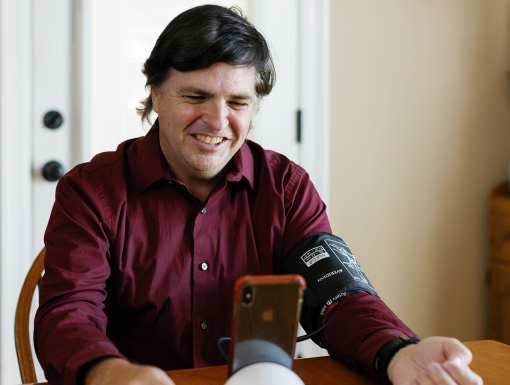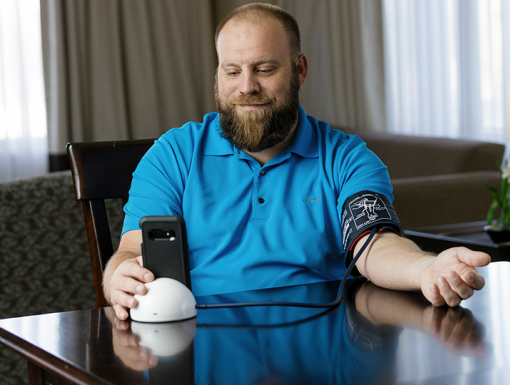
Avoid White-Coat Hypertension: 6 Tips for Stress-Free Blood Pressure Readings
You step into the bright doctor’s office that is designed to make you feel at ease. You hear the gentle hum of the medical machinery that’s there to help you. The friendly nurse places a cuff around your arm to take your blood pressure. Then a flutter of your heart turns into a racing heartbeat.
This may be a little bit more than just nerves. There is a term for when your blood pressure goes up at the clinic but is usually normal at home. It’s called “white-coat hypertension,” also known as white-coat syndrome. And if you have it, you are not alone!
What is white-coat hypertension (high blood pressure)?
White-coat hypertension occurs when your blood pressure readings are higher at the doctor’s office than at home or in other settings. It gets its name from the white coats traditionally worn by physicians and clinicians.
This condition is not uncommon and can happen to anyone. A significant portion of the population experiences anxiety and a temporary rise in blood pressure, medically known as “hypertension,” when placed in a clinical or medical environment. According to a 2019 report published in the medical journal Hypertension, 10% to 20% of adults without a diagnosis of high blood pressure experienced white-coat hypertension in a clinical setting. Some studies indicate that white-coat hypertension may occur more often in children, older adults, women, and those who have office blood pressure readings that are close to the threshold of a high blood pressure diagnosis.
White-coat hypertension is the opposite of a condition known as “masked” hypertension. People with masked hypertension have normal blood pressure in a clinical setting but high blood pressure when measured outside of it.
What does white-coat hypertension feel like?
High blood pressure alone sometimes does not show any obvious symptoms. Here are some hints that you may experience white-coat hypertension:
- Higher blood pressure readings at the office
- Anxiety or discomfort in clinical settings
- Increased heart rate in clinical settings
Why does white-coat hypertension happen?
White-coat hypertension can have both mental and physical causes. Your body may sense going into the exam room, the act of having your blood pressure checked, or the fear of being diagnosed with hypertension as stressful events. This triggers the endocrine and sympathetic nervous systems, contributing to a “fight or flight” response like what one would experience in a dangerous situation.
Others may create more of a self-fulfilling prophecy. They experience stress related to the doctor’s office or past experiences they may have had there. Or expectations that their blood pressure reading might be high can even create anxiety. Over time, their minds and bodies become conditioned to create elevated blood pressure in that setting.
Blood pressure is influenced by many factors and fluctuates throughout the day. It is normal for blood pressure to differ based on the time of day, your emotional or physical state, the fit of the blood pressure cuff, or if you have rested before the reading.
How do I manage white-coat hypertension?
While it can be tempting to ignore white-coat hypertension, newer studies show that white coat hypertension may be an indicator of true hypertension and/or progress to sustained hypertension.
On the other hand, this temporary elevation of blood pressure may be misinterpreted, leading to unnecessary treatment or medication.
Here are six strategies to try to avoid an occurrence of white-coat hypertension.
- Advocate for yourself. Find a doctor who encourages open and honest communication. Building a strong doctor-patient relationship can help to ease anxiety and improve your care.
- Prepare. Avoid activities before your visit that might temporarily raise your blood pressure, such as drinking caffeine, exercise and smoking.
- Relax. Practice deep breathing or meditation before and during the blood pressure measurement to stay calm and centered.
- Find a distraction. Bring reading materials or look for posters around the office to read during measurement. Ask the doctor or nurse to speak softly to help take your mind off the test.
- Stay informed. Ask your doctor questions about your routine checkup and read about your condition before your appointment. Understanding your health leads to better decisions.
- Track your progress. Monitor your blood pressure at home and bring results to your appointment. Self-monitoring blood pressure at home helps to differentiate between white-coat hypertension and sustained hypertension.
Ochsner Digital Medicine
Have you already been diagnosed with high blood pressure? For those seeking an innovative and convenient approach to holistic health, consider Ochsner Digital Medicine. This program allows you to monitor and manage your high blood pressure from the comfort of your home, without extra stress-inducing clinic visits. Ochsner Digital Medicine offers:
- Convenient care. An easy-to-use digital cuff allows you to regularly check your blood pressure from wherever you are.
- Personal support. A care team that consists of a licensed clinician and a panel of expert health coaches guide you toward better health.
- Empowerment and results: Digital Medicine engages and encourages you to take a more active role in managing your health, and 4 out of 5 program members reach their blood pressure goals in six months.
The Digital Medicine program also uses simple digital tools and personalized clinical support to manage weight and Type 2 diabetes.
Take control
Though white-coat hypertension may not be harmful on its own, consistently high blood pressure readings in various environments can pose long-term health risks. To manage white-coat hypertension, equip yourself with strategies to minimize stress, such as monitoring your own health at home. and considering Programs like Ochsner Digital Medicine can empower you to take control of your blood pressure and live your healthiest life.
If you experience spikes in your blood pressure at the doctor's office or have been diagnosed with hypertension, remember that you're not alone. There are resources and strategies are available to help you feel at ease and be more heart healthy.
Track your high blood pressure from home. Join Ochsner Digital Medicine today.



